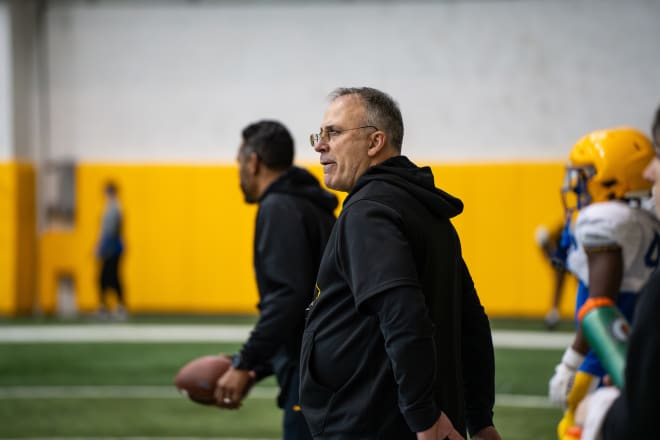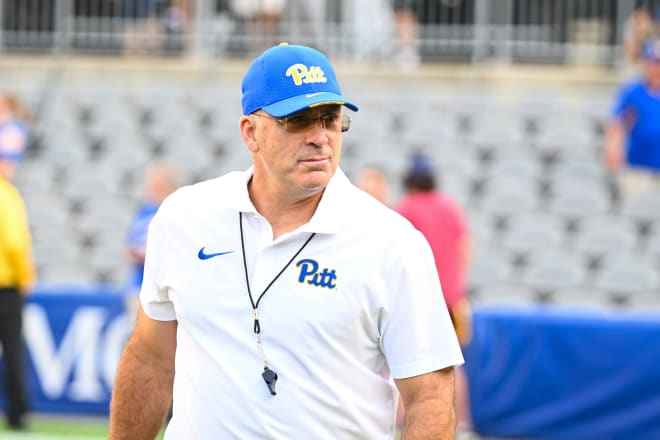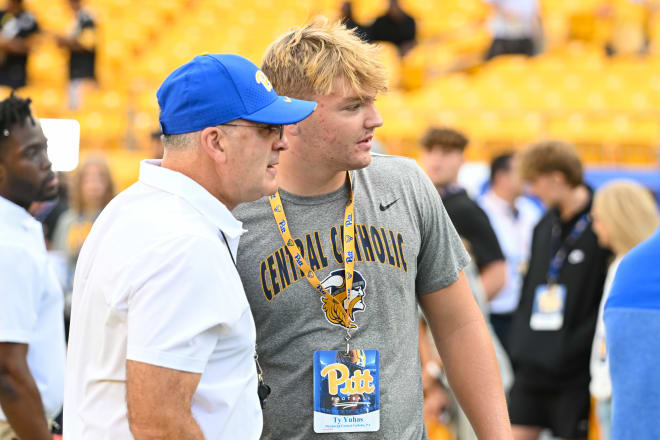The 3-2-1 Column: Offseason tones, offensive concerns and more
In this week's 3-2-1 Column we're thinking about the tone of Pitt's offseason, a bevy of concerns, hoops optimism, recruiting and more.

THREE THINGS WE KNOW
The tone of an offseason
For the longest time, I’ve been fascinated by the way an offseason unfolds and how it is perceived by fans.
That’s probably due to the message boards here on the site. They present a unique and anonymous window into the mindset of the most passionate Pitt fans - an unfiltered, unfettered and occasionally unhinged perspective from a vocal portion of the fanbase.
The boards may not represent what every Pitt fan is thinking, but they represent what a lot of them are thinking, and it’s likely that even if the majority have tamer feelings, there’s probably a shared thread that runs throughout the fanbase.
That’s what we get exposed to every day by frequenting these boards, and to me, it’s never more interesting than during the offseason.
I’ve talked before about the phenomena of how the last game can really set the tone for the offseason - even if it flies in the face of evidence to the contrary. The classic example is the contrast between the offseason after the 2007 season and the offseason after 2008. In the former, Pitt fans were on cloud (13 to) nine. Fresh off the upset in Morgantown, the sun couldn’t be shining brighter. Never mind the fact that the team went 5-7, the second losing season in Dave Wannstedt’s first three years and a third consecutive postseason sitting at home.
Fast forward a year, and things couldn’t be gloomier. Pitt had just lost one of the worst bowl games in history, capping a season that also witnessed bad losses to Bowling Green and Rutgers. And to make matters worse, the Panthers would enter 2009 without LeSean McCoy or Scott McKillop and with Bill Stull - and I’m not sure which of those troubled the fans the most.
Never mind that the 2008 Pitt team went 9-4, posting the team’s best overall record in six years and best regular-season record - 9-3 - since 1982. None of that mattered much in the wake of the Sun Bowl (or such fan-favorite moments like Miles Dieffenbach committing to Penn State. Remember that one?).
I can’t speak to what the conversations were like at Cupka’s or Lot 17, but I saw the contrast between post-2007 and post-2008 play out on the message boards in real time. In the former, it was sunshine and rainbows. In the latter, it was the worst of times, and it was also the worst of times.
Of course, we know what happened at the conclusion of each of those offseasons. The period of basking in the afterglow of 13-9 crashed hard with a season-opening loss to Bowling Green. The period of sulking in the dark from the 3-0 Sun Bowl gave way to Pitt’s first 10-win season in nearly 30 years.
What I’m saying is, not only did the offseason vibe not necessarily reflect what had come before it, but it also didn’t exactly portend the coming season accurately. 2008 was demonstrably a better season than 2007, and 2009 was better than 2008, but the tones of those offseasons were reversed from the reality of the situation.
I’m not saying that’s difficult to understand. The 13-9 game was a high-water mark in Pitt history; the 3-0 Sun Bowl was a low-water mark in college football history. But just like those games set the tone for the coming offseason, so too were those tones upset by what actually happened.
Maybe that’s just the natural cycle of things. A season happens. The offseason is spent living as if that season will forever be the state of things. Then a new season happens.
I guess that's the way the whole darn comedy of college football keeps perpetuatin' itself down through the generations, westward the wagons, across the -
Ah, look at me. I'm ramblin' again. I haven’t even talked about the current offseason - and what everybody seems to be thinking about the season to come.

The current tone
Yeah, right now, it’s not good.
It’s not like the post-Sun Bowl 2008 offseason. That was doom and gloom, but this is different. It’s not even like the post-2017 offseason. That one was coming off a losing season, but it ended on a high note with the win over Miami and the breakout performance by Kenny Pickett.
This is something different, something we haven’t seen around here in close to 30 years.
The 3-9 season last year took a lot out of Pitt fans, I think. And it wasn’t just the record. I mean, the record was bad enough, but there was more to it than that. Because couched inside that record was a series of downright awful decisions - decisions largely related to the personnel at quarterback, decisions largely responsible for the outcome of the season.
It wasn’t just that Pitt was bad. It was that you could convince yourself they were almost willingly bad. Intentionally bad. That’s how low things felt in late September and early October when there was no earthly reason to stay with the quarterback who was clearly not able to perform.
That took a lot out of people. Pitt fans were drained by the experience, and in an era where the necessity of fan engagement is at an all-time high, the worst thing a program can have is a drained fanbase. Apathy, more than anger, can kill a program, and the anger of last season’s performance wilted to apathy not long after the season ended (and probably earlier than that).
Even worse, and perhaps what’s weighing the heaviest on Pitt fans, is the Bigger Picture. In that particular frame, it’s not hard to conjure an image of a trajectory with the ACC Championship Game as the apex and a fairly direct line going in the opposite direction since then.
There were ups along the way, of course. There was the exciting win over West Virginia in the renewal of the Backyard Brawl, although that one lost some luster with the disappointment in Morgantown this season. There was also the four-game winning streak in November 2022 that probably looks better on paper than it felt at the time.
The Sun Bowl was an arrow-up moment, though; you can’t take anything away from that win in El Paso.
But on the whole, the 26 games since the win over Wake Forest in Charlotte have seen more downs than ups - quite literally, as Pitt is 12-14 over that stretch and the bad losses sure do seem to outweigh the good wins (the latter feels pretty much limited to the 2022 Brawl, the Sun Bowl and the 2023 Louisville game, while the former features the Georgia Tech and Louisville games in 2022 and a whole litany of disasters last season).
That’s a tough stretch, and it feels even more stark because of how high the program was in December 2021. In a way, the current offseason isn’t just the offseason after the 2023 season - it’s the latest stage in the extended offseason since that championship. Not every step has been downward, of course; Pitt did win nine games in 2022 and finished the season ranked in the top 25 (with some serious NFL Draft success after that). But the fact remains that there have been plenty of steps down over the last two years, and I think that’s influencing the overall vibe of the fanbase as much as anything.

The role of the offense in the offseason concerns
In the doldrums of the Frank Cignetti era, I’m sure many Pitt fans issued some version of the following edict:
“Go find a coordinator who’s calling a prolific offense at a lower level and bring him to the ACC.”
As we all know, that’s what Narduzzi did: he grabbed the architect of the most prolific offense at the FCS level and brought him to Pitt, which inevitably brought some version of the following response:
“No, not that coordinator who’s calling a prolific offense at a lower level.”
That’s not entirely accurate, of course. I actually think quite a few Pitt fans - most, even - were bullish on the Kade Bell hire. Narduzzi went so far outside his comfort zone in making the hire that it’s almost still a bit surprising, and if nothing else, the hire showed a real intention by Narduzzi to do something different in the wake of his worst season.
So that’s good. And Bell’s resume is strong, even if his success has been limited to FCS and Division II.
But it doesn’t seem like many are bullish on what Pitt’s offense can be in 2024, and I think there are a few reasons for that.
For starters, I think many fans who were excited about Bell tempered their enthusiasm a bit as the rest of the offensive staff was filled out. It wasn’t that Pitt fans were disappointed to see Dave Borbely, Andre Powell and Tim Salem get let go; rather, I think they were disappointed that the replacements for those three included two FCS coaches and a G5 assistant. And one more FCS coach was added when Tiquan Underwood left for the New England Patriots.
Say what you will about Borbely, Powell and Salem, but they’ve at least got about 150 years of combined experience coaching at the power-conference level.
Their replacements - Jeremy Darveau for Borbely, Lindsay Lamar for Powell and Jacob Bronowski for Salem (although he’s here for the special teams coordinator job as much as anything) - have much less experience at that level. Like, virtually no experience at the power-conference level. And that goes for receivers coach JJ Laster, too.
I don’t know if any Pitt fans are pining for a return from any of the departed coaches, but they certainly have questions about the bona fides of their replacements.
So whatever shine there was on the Bell hire lost a bit of its luster as the offensive coaching staff filled out in the ensuing weeks. Praise for Narduzzi going in the complete opposite direction grew into concern about how far afield he had gone. And the need for an offensive overhaul, which no one disputed, got overshadowed by the resumes of the coaches responsible for installing that overhaul.
And that’s to say nothing of the players. Nate Yarnell has a 2-1 record as a starter, but he’s hardly a sure thing. The running backs are fine if they stay healthy and the tight ends are fine if they get used. But the receivers don’t have an obvious No. 1 playmaker and the offensive line looks mighty thin right now.
Taken together, then: Pitt is installing a first-year offense run by a coordinator who has never called plays at the FBS level with a supporting cast of coaches who almost all came from the FCS ranks and a roster that may end up being a net improvement over last season but is not without considerable holes.
It’s not that it can’t work. It’s that, in order for it to work, a whole bunch of things that have never happened before have to happen in the same season.

TWO QUESTIONS WE HAVE
Why is Capel so optimistic?
While optimism might be in short supply regarding the South Side, I think upper campus has a bit more to go around.
Hopefully you saw my interview with Jeff Capel last week. I split it into two parts because it was so long - around 40 minutes in total - and the reality is, we probably could have talked for another 40 minutes or so, because even though we spent a lot of time covering everything from the Selection Sunday snub to Bub Carrington’s NBA decision to the transfers Pitt added and more, there were topics we didn’t even get to discuss.
I guess that’s the sign of a good interview: we got a lot of great stuff out of it and we didn’t cover everything I hope we would.
But one thing I couldn’t help noticing during our conversation - and I’m guessing you picked up on it, too - was Capel’s optimism.
He’s really excited about this coming season. Even without adding another transfer, Capel thinks this Pitt team is going to be pretty good. Maybe really good.
Why is that?
I think it starts with the guards. Pitt’s got four of them for the roster, and it looks like it could be the best group Capel has had in the back court since he got to Pitt. It’s not hard to see why Capel likes them so much: Jaland Lowe as a sophomore? Ishmael Leggett in his second year playing high-major ball? Damian Dunn aș a priority guard transfer? Brandin Cummings as a promising freshman?
That’s a really good group of guards. If Carrington had stayed, I would say it’s arguably the top back court in the ACC. Without Carrington, we’ll have to wait to apply that title, but I think Lowe and company will make a legitimate case.
Let’s skip over the wings for now and go to the center position. That’s a spot where Capel is really excited (maybe not as excited as he is about the guards, but really excited nonetheless). He told me Florida State center Cam Corhen was one of his top overall targets in the transfer portal, a player the Pitt staff was keeping an eye on dating back to when the Panthers hosted the Seminoles in February, and when he entered the portal, the coaches were on him quickly. Capel thinks he found a center who can flourish on an individual level and give the Panthers something they haven’t had since John Hugley’s best season:
A true scoring threat in the post.
So Pitt’s got the guards and the center; what about the wings? That’s the one area with question marks, but even then, Capel is optimistic.
In fact, if you watch those interviews with Capel, he speaks as highly of Zack Austin and Guillermo Diaz Graham as he does of any other players. He feels like both guys made strides last season and should be ready to make even bigger strides this season. That’s what Pitt really needs: strong play from Austin and Diaz Graham on the wing, because while the staff is working to add another player in that area, those two are going to be relied on for a lot of minutes and contributions.
Capel seems bullish on that happening.
But there’s one other thing that I think has Capel feeling optimistic. I think Capel feels, and rightfully so, that he and his staff have figured something out in the last three years.
By his own admission, Capel didn’t have a great plan for building a team when he first arrived at Pitt. He was too caught up in the Duke model, on a few levels, and it created some difficult situations.
But in the last three years, I think Capel and his staff have found a formula. Whether it’s the transfers they’ve brought in or the high school players they’ve recruited (some of them, anyway), the additions to the roster in the last few offseasons have been almost all positive.
Whatever they’ve been doing has been working, with a pair of 20-win seasons as proof. And between the carryover from last season’s roster and the potential of the incoming players, it looks like this season should keep that momentum going.
Capel seems to have figured it out, and I think he knows it.

Has NIL impacted recruiting?
This question came up during our live stream on Wednesday night, and I think it’s an interesting one.
This spring has been one of revelations about the process of landing transfers. Or perhaps “resignations” would be more in line, since I think many people have largely resigned themselves to accepting the current system for what it is:
An open market with no structure whatsoever and players going to the highest bidder.
It has made the transfer portal a college form of free agency, one without parallel in the pros, and it has completely upended the nature of college sports.
But what about recruiting? Has NIL had the same kind of impact on the pursuit of high school prospects?
In short, not really. But it’s having some impact.
Where I don’t think you see a big impact is in the June official visit period. For the most part, those recruitments largely play out like they used to. NIL is in the conversation at times with certain prospects, but the recruits who commit in June are mostly doing so for the same reasons they used to commit:
Academics, environment, facilities, development, relationships.
In that way, it’s one of the few things in college football that still looks more or less the same as it did five years ago. There’s not many of those remaining, so enjoy it while you can.
Because the reality is, NIL does play into recruiting - just not necessarily in June.
Where NIL becomes a factor in recruiting is later in the calendar, somewhere around December when all of those guys who visited and committed in June are getting ready to sign and a few other schools find themselves short at a particular position.
That’s when NIL becomes a factor.
It used to be that schools would try to poach longstanding commitments in the weeks leading to Signing Day by enticing them to take a visit.
“No pressure, nothing like that,” would be the sales pitch. “Just take a weekend trip on our dime. Who doesn’t like to go away for a weekend? And with all expenses covered, no less.”
That’s how it would start, and a lot of times, by the end of that no-pressure weekend, the school hosting the recruit would have made some progress toward loosening the pre-existing commitment.
Throw in a successful in-home visit or two, and you’re looking at a potential flip, the old-fashioned way
How quaint.
Because now, in addition to those tactics, there’s another big one for schools to levy to try to get a flip:
Cash.
This is where NIL becomes a factor. This is where schools can leverage their NIL operation and skip over all the sweet talk and relationship-building. It’s quicker and more to the point:
“Here’s what we can offer you.”
Skip the preliminaries and get down to business. Want to flip a kid who’s been committed for six months? Let the money do the talking.
So that’s where NIL comes in with high school recruiting. Sure, it’s going to be a bigger element in the recruitments of top prospects, but for the most part, NIL’s biggest impact on high school recruiting has been the tool it gives coaches when they need to operate with a sense of urgency before Signing Day.

ONE PREDICTION
June will be an interesting test
This June should look a lot like previous Junes, but there’s one big difference, of course:
The coaching staff.
As such, this June will be an interesting test for that group. I’m fairly confident they will land a lot of commitments. That’s just what happens in June, and with 36 official visitors already lined up - a number that will undoubtedly change between now and Memorial Day (and beyond) - there’s going to be no shortage of potential recruits to land.
I’m sure they’ll land them, but it’s going to be very interesting to see what that looks like. Recruiting is just one of the questions about the new coaches, but it’s a big one, and June provides a very tangible test to see how they perform in a setting that is tailor-made for recruiting success.
So far, we’ve got three four-star prospects confirmed for visits already.
Last year, Pitt hosted 14 four-star recruits for June official visits. But that might have been an outlier; in June 2022, one five-star and five four-stars came to campus. And in the summer of 2021, six four-star prospects took official visits in June.
So this June is shaping up more like the Junes of 2021, 2022, 2019 (seven four-stars) and 2018 (two four-stars) than last June, which was the high-water mark for star-studded official visits.
It’s worth noting that, of those 14 four-star recruits who visited Pitt in June last year, four signed with the Panthers - defensive tackles Francis Brewu and Jahsear Whittington, defensive end Sincere Edwards and linebacker Cameron Lindsey. You’d like to have a better hit rate than 4-for-14 - although at .286, Pitt’s June 2024 success rate would be the Pirates’ second-best hitter - but that’s still a solid haul for the Panthers, and it was driven by the sheer volume of four-star guys the coaches brought to campus for visits.
This year doesn’t look like it will have that star volume, but the June slate of visits will provide opportunity. Beyond the four-star targets, Pitt will have plenty of recruits on campus who can be good additions to the roster.
And that means it will be a chance for this staff to flex its recruiting muscle. Like we said in the last section, there’s a lot that can happen between June and December, and the work certainly doesn’t end with a commitment in June. But the June official visits provide an opportunity for coaches to show what they can do:
In a controlled environment where the entire experience is designed to make Pitt as enticing as possible, how do these new coaches function? None of them has really had to recruit in that setting yet, so we don’t have any strong indication one way or another of how they will perform.
But we’ll find out next month. Next month, close to 40 recruits - and it may end up being more - will come to campus as willing buyers in college football’s biggest sales event of the year.
Will Pitt’s new coaches earn the coffee?
It’s going to be really interesting to watch.
